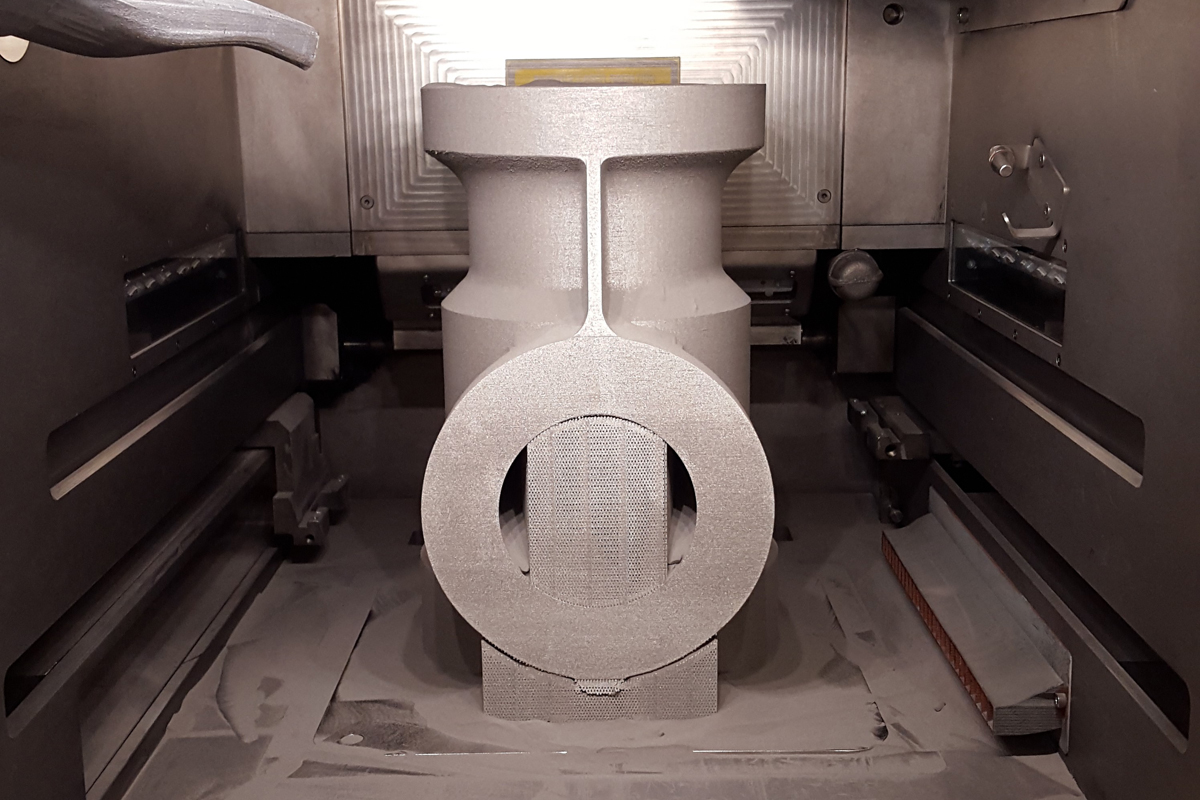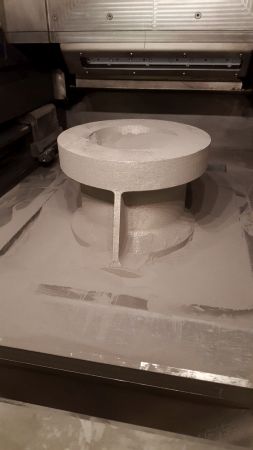Simply space! Huge titanium detail in 6.5 days

SLM Solutions , a leader in the development of new technologies for the 3D printing of metals, completed a project to manufacture a titanium product for the aerospace industry with a size of 31 x 22.2 and a diameter of 21.9 cm.
Today it is the largest component manufactured on the SLM 280 additive unit with two 400-watt lasers. It was this machine that made it possible to print a product of this size in a relatively short time compared with traditional manufacturing technology.
The standard size of the build platform in 3D-printers of this class is 250 mm x 250 mm. However, the SLM 280 has an enlarged platform of 280 mm x 280 mm in size, which makes it possible to print larger items.
')
Thanks to developments in the field of 3D printing of metals using selective laser melting technology (including titanium) for the aerospace industry, given the high strength and low weight of this metal, SLM Solutions has become one of the leading companies fulfilling orders for manufacturers of complete equipment. SLM Solutions has managed to overcome the limitations associated with the size of the camera construction, and other difficulties encountered in the manufacture of large products made of titanium, and continues to improve its technology in this area.

The process of 3D printing from titanium powder
As Mike Hansen, the implementation engineer for the North American division of SLM Solutions, explains, success in the field of 3D printing by titanium is especially important: titanium is a very hard and cracking metal due to high residual stresses, which has become a serious problem. “The geometry of the part was not particularly difficult, but the difficulty was to make such a large product out of titanium using additive technology,” said the engineer.
This task was solved by the developed and patented SLM Solutions system consisting of two lasers. Processing the product in the overlap zone simultaneously with two lasers allowed not only to speed up the printing process, but also to manufacture a larger product. SLM Solutions tested material in the overlap area, which confirmed the absence of any difference in material quality between the areas printed by one laser and the areas in the overlap area, which the two lasers operated alternately. SLM Solutions engineers performed several iterations to prepare the file and print several test samples to ensure that the task is completed. The client needed a way to produce this product, providing cost and time savings as well as weight reduction .
“This product is remarkable for its size and the fact that it was made of titanium in six and a half days without interruptions in the printing process,” says Hansen. “The fact that the SLM 3D printer can work for such a long time without requiring cleaning or other maintenance is in itself extremely important.”
Although 3D printing technology usually attracts attention with its ability to reproduce unique geometry, this product for the aerospace industry was not particularly difficult from this point of view. However, to obtain a titanium part of this size in such a short time would hardly be possible using traditional machining technology.
The process of manufacturing by means of traditional machining would take several weeks.“The technology of additive manufacturing is not bound by the limitations of traditional machines and tools, so we can create more organic forms, and the entire cycle of designing and developing critical products for the aerospace industry is significantly reduced,” Hansen said.
Richard Grylls, Ph.D. in metallurgy, head of implementation and technical director of SLM Solutions in North America, gave the following comment: “Given the size of the product, the manufacturing process using traditional machining tools would take several weeks; it would have taken four or five changeovers. In other words, this would be a very costly process. It would take even more time to manufacture the product using the casting technology , since the equipment would be needed, and the manufacturing process can take up to six months. In addition, traditional equipment has a high cost. We completed the task much faster, although the cost of the product was higher. Nevertheless, given the time saved, such costs are justified for a critical product of this size. ”

Turbine blade, printed on SLM 280HL additive unit
SLM Solutions has achieved impressive results in terms of manufacturing speed, quality and density of the final product. Hansen noted that “meeting stringent quality requirements and material specifications when using titanium in highly regulated industries such as the aerospace and automotive industries requires numerous materials testing and optimization of parameters to ensure that the customer gets exactly what he needs. ".
Requirements for quality control in the aerospace industry are quite extensive: to test the product for voids or porosity, as a rule, this method of non-destructive testing, such as computed tomography, is used, but the client can choose destructive testing and cut the product. “We first carried out a non-destructive testing of the product, and then testing under conditions close to real, by installing the product on the engine and having developed the resource before destruction,” says Hansen.
As additive manufacturing technologies develop, SLM Solutions is seeing an increasing demand for its solutions. However, materials and manufacturing processes are improved so quickly that standards do not keep pace with them. “We are increasingly turning to companies that use traditional technologies, but are seeking to increase production speed while maintaining quality and want to take advantage of additive manufacturing,” added Hansen. “This industry is changing literally every day and is developing very fast, but we are seeing a gap between the pace of development of additive manufacturing technologies and the ability of some industries, in particular, aerospace and automotive, to certify new materials and technologies just as quickly.”
Product dimensions: 31 x 22.2 cm, diameter 21.9 cm
Material: Ti64
Print duration: 6.5 days
Additive setup: SLM 280 with two 400 W lasers
Source: https://habr.com/ru/post/446316/
All Articles